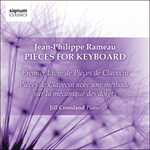At first sight, little about the
Premier livre de pièces de clavecin of 1706—consisting of a single Suite in A minor—would seem to hint at Rameau’s later glories. The general outline of movements in this little oblong volume more or less resembles that in the harpsichord collections of Jacquet de la Guerre, Louis Marchand and their various lesser imitators. But even from the pen of a twenty-three-year-old composer from the provinces there are drops of pure gold. The Prélude, one of the last unmeasured examples of that genre, is of startling intensity. The tarantella-like gestures of its fast second section give way to the bittersweet first Allemande, which recalls the great art of the French lutenists. This in turn leads to a quicker type of the same dance; these movements attest to the danceability of this genre, which was later lost under so many layers of refinement. The gestures of the Courante and Gigue are completely steeped in tradition, and they both burst at the seams with potency and character. After a gentle pair of Sarabandes, the Vénitienne forms the emotional core of this suite. This gem is a fetching depiction, perhaps, of the gondoliers in the grounds of the Palace of Versailles. With the vigorous Gavotte and wry Menuet Rameau takes us from the sublime to the pastoral and entertaining, much as Marin Marais would conclude a suite with, for example, a Feste champêtre or a similar peasant-like tune. The order of movements is presented here as it is in the original printing, with this dramatic narrative in mind.
from notes by Mahan Esfahani © 2014
À première vue, il n’y a pas grand-chose dans le
Premier livre de pièces de clavecin de 1706—il se compose d’une seule Suite en la mineur—qui semble laisser supposer l’avenir glorieux de Rameau. Le contour général des mouvements dans ce petit volume rectangulaire ressemble plus ou moins aux recueils de musique pour clavecin de Jacquet de la Guerre, Louis Marchand et de leurs divers imitateurs de moindre importance. Mais, même sous la plume d’un compositeur provincial de vingt-trois ans, il y a des gouttes d’or pur qui s’écoulent. Le Prélude, l’un des derniers exemples non mesurés du genre, est d’une intensité saisissante. Les gestes de tarentelle de sa deuxième section rapide font place à la première Allemande douce-amère qui rappelle le grand art des luthistes français. À son tour, elle mène à un exemple plus rapide de la même danse; ces mouvements attestent du côté dansable de ce genre, qui se perdit ensuite dans tant de couches de raffinement. Les gestes de la Courante et de la Gigue sont complètement imprégnés de tradition et elles regorgent de force et de caractère. Après deux Sarabandes douces, la Vénitienne constitue le noyau émotionnel de cette suite. Cette merveille est un ravissant tableau, peut-être des gondoliers dans le parc du Château de Versailles. Avec la vigoureuse Gavotte et le Menuet ironique, Rameau nous fait passer du sublime au pastoral et au divertissant, un peu comme Marin Marais conclurait une suite avec, par exemple, une Feste champêtre ou un air rustique analogue. L’ordre des mouvements est présenté ici comme dans l’édition originale, sans jamais perdre de vue cette narration dramatique.
extrait des notes rédigées par Mahan Esfahani © 2014
Français: Marie-Stella Pâris
Auf den ersten Blick deutet im
Premier livre de pièces de clavecin von 1706 (das aus einer einzigen Suite in a-Moll besteht) wenig auf die späteren großartigen Werke Rameaus hin. Allgemein gleichen die Sätze in diesem kleinen länglichen Band mehr oder weniger jenen in den Sammelbänden für Cembalo von Jacquet de la Guerre, Louis Marchand und ihren verschiedenen unbedeutenderen Nachahmern. Doch selbst aus der Feder eines 23-jährigen Komponisten aus der Provinzfließen Tropfen puren Goldes. Das Prélude, eines der letzten Beispiele dieser Form ohne Taktstriche, ist von verblüffender Intensität. Die Tarantella-artigen Gesten des schnellen zweiten Teils weichen der bittersüßen ersten Allemande, die an die große Kunst der französischen Lautenisten erinnert. Diese führt ihrerseits zu einer schnelleren Variante desselben Tanzes; beide Sätze bestätigen die Tanzbarkeit dieser Form, die später nach mehrfachen Verfeinerungen verlorenging. Die Gesten der Courante und der Gigue sind ganz in der Tradition verhaftet, und beide bersten vor Kraft und Charakter. Die auf zwei gemächliche Sarabandes folgende Vénitienne bildet das emotionale Zentrum der Suite. Dieses Juwel ist eine bezaubernde Darstellung vielleicht der Gondolieri auf dem Gelände des Schlosses von Versailles. Mit der kraftvollen Gavotte und dem ironischen Menuet geht Rameau von sublimer Musik zu ländlicher und unterhaltender über, ganz so, wie z. B. Marin Marais eine Suite mit einer Feste champêtre oder einer ähnlichen ländlichen Weise beendet hat. Die Sätze sind hier wie im Erstdruck angeordnet, wobei der dramatische Ablauf berücksichtigt wurde.
aus dem Begleittext von Mahan Esfahani © 2014
Deutsch: Christiane Frobenius



 Rameau: Pièces de clavecin
Rameau: Pièces de clavecin
